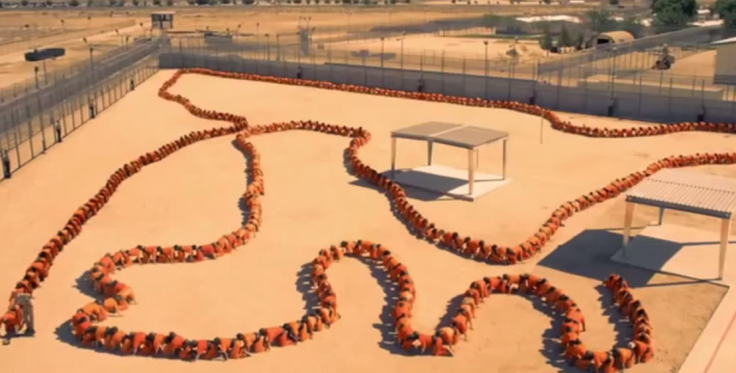Creating A Human Centipede: Is It Medically Possible?

In 2009, Dutch filmmaker Tom Six introduced the world to a whole new meaning of the term “ass-to-mouth” when he released the now-cult horror classic The Human Centipede: First Sequence, about a German surgeon known for separating conjoined twins, who, in retirement, developed a sick fascination with recreating those junctions. He captures three tourists and creates a “Siamese triplet, connected via the gastric system.” A human centipede.
Amid the buzz, controversy, and disgust the first film elicited, Six quickly announced he’d be making two sequels. The gorier The Human Centipede 2: Full Sequence featured a mentally ill British fan of the first film one-upping the surgeon by creating a 12-person human centipede. If you thought that was bad though, The Human Centipede 3: Final Sequence, which will be released later this week, takes the cake. Set in a Midwest prison, 500 inmates will comprise this centipede.
Surely, many questions arise when thinking about these films. Should I be disgusted or laugh at the idea of a person’s face being sewn to another person’s ass? What does this film, and its subsequent cult following, say about our society? Is this art? But perhaps, the most pressing question for most of us — particularly us at Medical Daily — is whether or not the operation is even possible. The short answer: yes, but it gets complicated.
There’s a difference between medically possible and medically accurate — the first film was marketed as the latter. The films are far from medically accurate. Firstly, there's a good chance none of these people would have lived through the operation; most surgeons aren’t familiar with anesthesiology, especially with so many patients at once. They wouldn't have lived long after the operation, either. Before we can get into why, however, how about we lay down exactly what the operation entailed, as explained by the German surgeon himself Dr. Heiter (Dieter Laser):
“We start with cutting the ligamentum patellae, the ligaments of the kneecaps, so knee extension is no longer possible. Pull from B and C the central incisors, the lateral incisors and canines from the upper and lower jaws. The lips from B and C, and the anus of A and B are cut circular along the border between skin and mucosa, the mucous cutaneous zone. Two pedicled grafts are prepared and lifted from their underlying tissue. The V-shaped incisions below the chins of B and C up to the cheeks, connecting the circular mucosa and skin parts of anus and mouth from A to B and B to C. Connect the pedicled grafts to the chin-cheek incisions from A to B and B to C, creating a Siamese triplet, connected via the gastric system. Ingestion by A passes through B to the excretion of C. A human centipede, first sequence.”
If you’re lost, here’s a visual.

We all know feces is filled with infectious bacteria that'll infect us once we swallow it. Now consider the fact all of these “pieces” in the centipedes have fresh, open wounds in their faces and anuses, too. Dr. Louise Stuart Owen, a former resident in internal medicine at the Mayo Clinic, told FilmSchoolRejects that these people would likely develop a severe blood infection — called sepsis — before they even ingested the feces of the person in front of them. From there, their bodies would deteriorate quickly, starting with the brain. “They would not be able to think clearly,” Owen said. “They would not be mindful enough to obey commands or plan an escape. The pain would clearly be unbearable.”
Though that may be the first and most damaging thing to happen, there's a laundry list of other things that would most likely go wrong. Dr. Philip Coakley, a doctor in the UK, told Vice that a person’s natural instinct would be to vomit up whatever feces was forced down their throat. “That vomit would have nowhere to go and it is probable that some of it would be aspirated,” he said. Owen agreed, noting that stomach acid and feces would likely go into the lungs, causing difficulty breathing and pneumonia. Between the vomiting and crying, which blocks the nose, victims would probably have difficulty breathing.
Going further, Owen said that with no time to heal, the surgical staples connecting the victims would "dislodge" as they heave violently from vomiting. But even simple movements could dislodge the staples. “Each can still move their torso and thighs and arms,” Owen said. “They would be able to crawl and could pull apart (though this would be very painful and cause extensive bleeding). The staples/sutures would pull during movement and likely dislodge. A firm cough or vomit would likely cause them to at least partially dislodge.” In these cases, the person would most likely be left to bleed until they died — assuming an infection didn’t get them first.
Creating your own human centipede isn’t and will probably never be possible — thankfully — but that shouldn’t stop you from enjoying the franchise’s last installment, which comes out May 22. Maybe you'll find answers to those other questions we talked about. Plus, you'll get to see a 500-person human centipede. It's unreal.



























